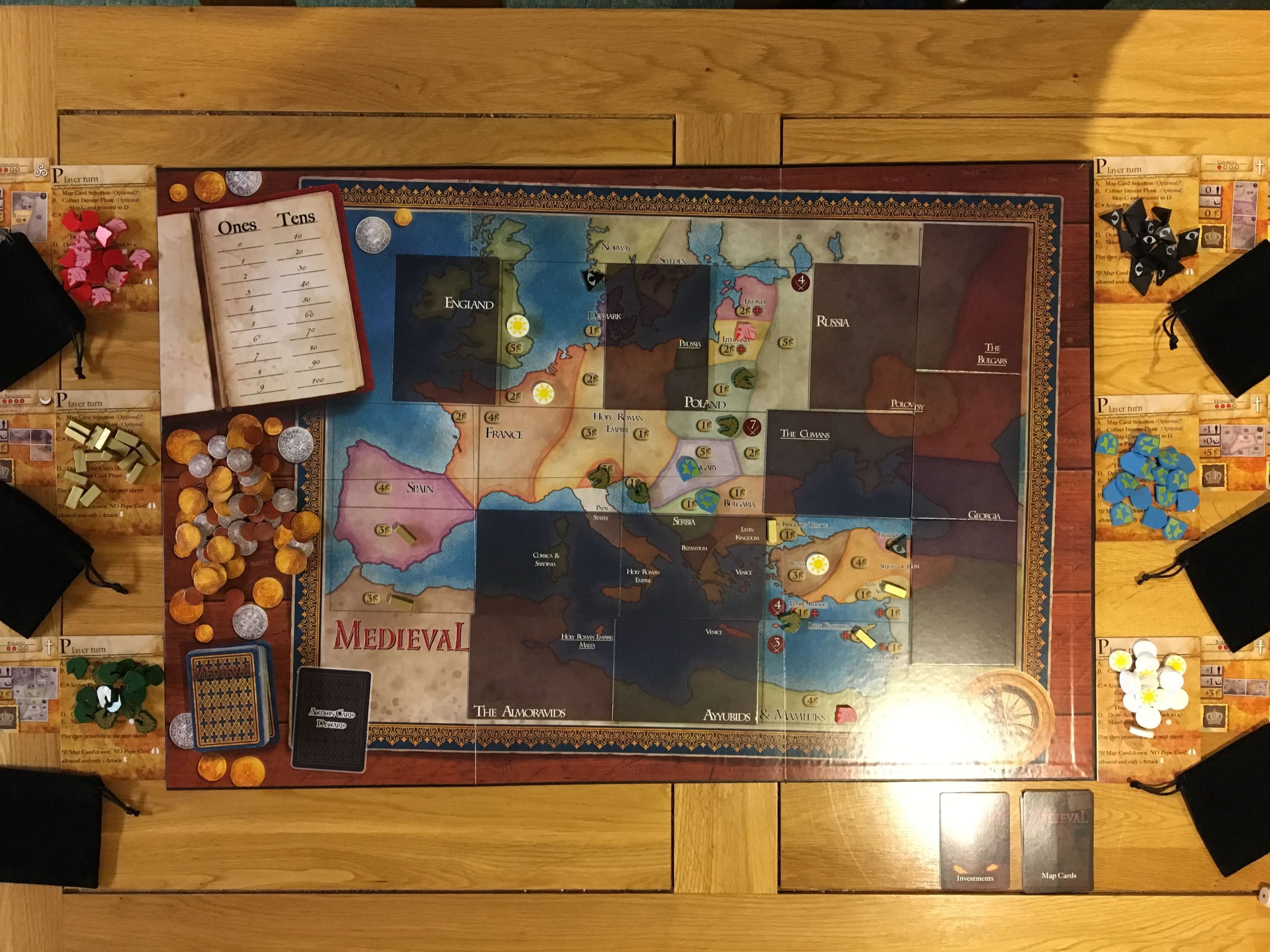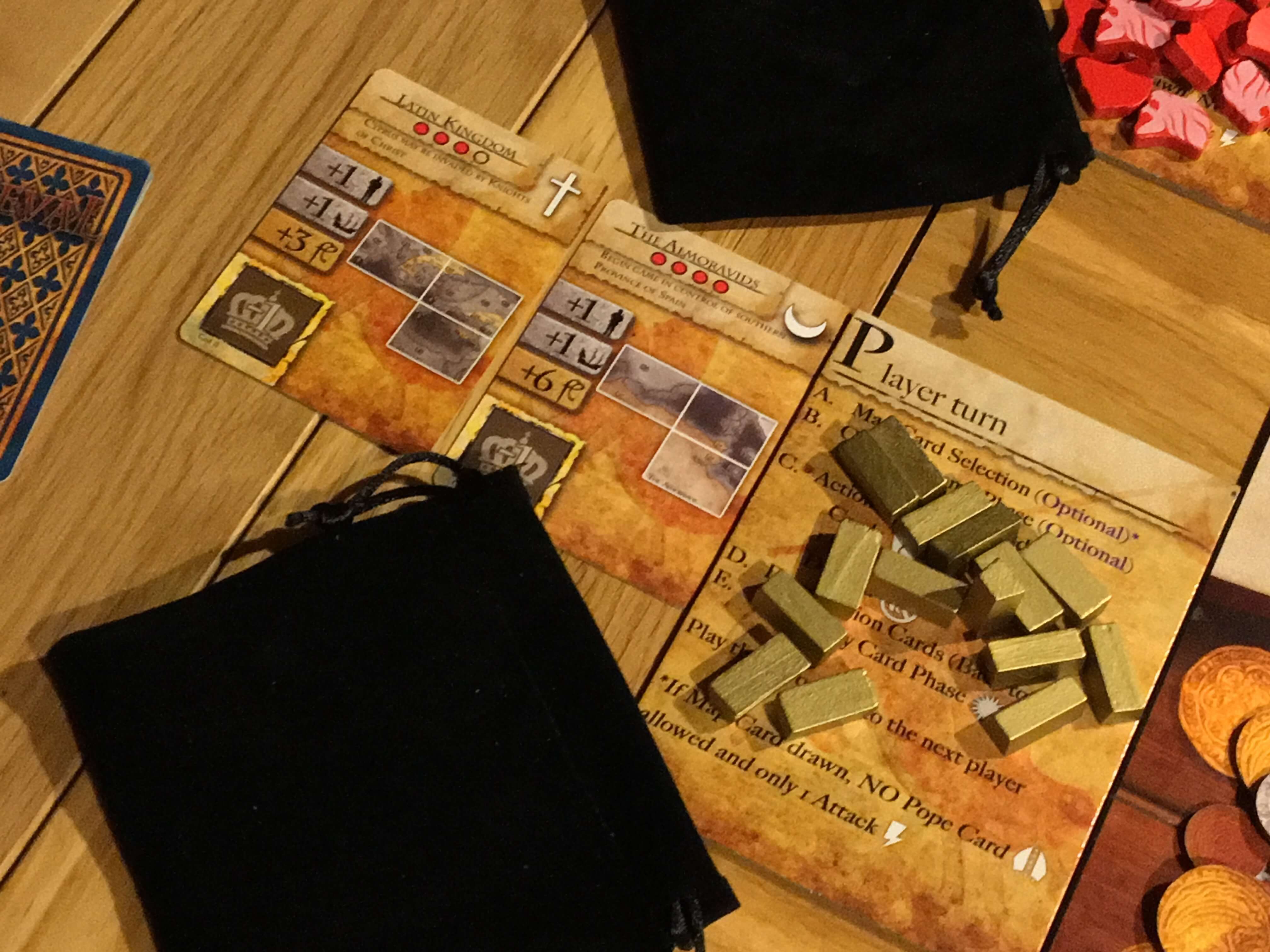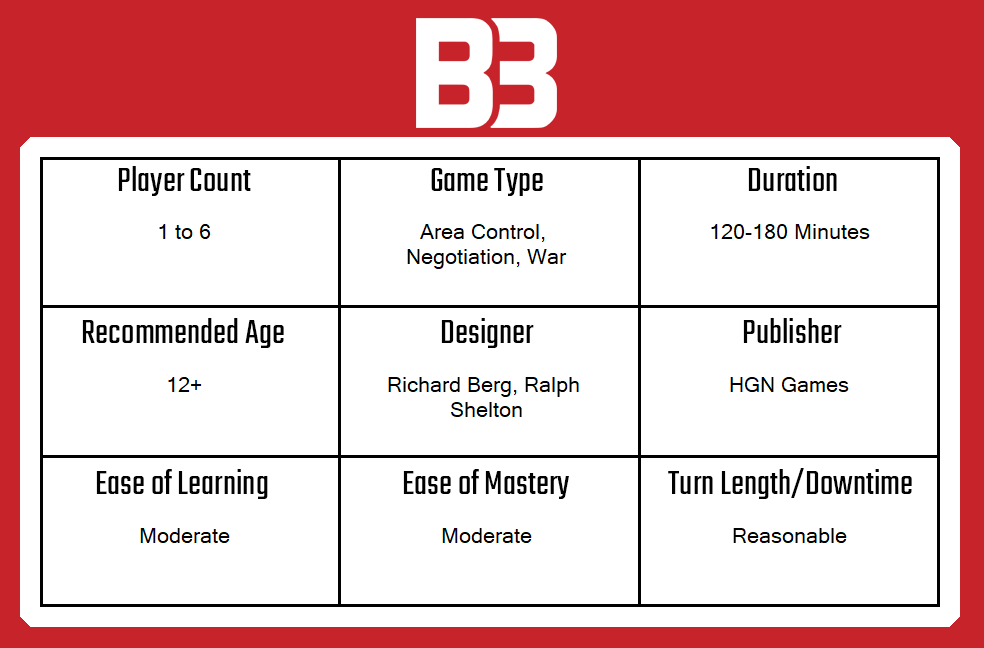Medieval (2018 HGN Games Edition) review — Total war?
Fans of grand strategy games like Total War and Europa Universalis take note — Medieval might just be the board game you’ve been waiting for. This six-player behemoth from HGN Games is a recently Kickstarted reimplementation of an older game that shares the same name, streamlining several rules and enhancing the gameplay for a modern audience. From excommunications and plagues to the onslaught of the Golden Horde, there are few games so ambitious as to capture the entirety of the middle ages in a game intended to last two to three hours. Is it any good, though? Let’s find out.
Overview
Medieval pitches players as a political cabal (think of The Knights Templar) who hold significant sway over one or more powers (usually two in a normal game) at the outset of The Middle Ages. You could argue that it more or less pitches the players as the powers themselves in a kind of strange alliance, but however you dress it up, it’s an excuse for players to be able to draw, draft or otherwise select from a huge range of powers like France, England, The Almoravids, Georgia and so on.
What makes the game so interesting is that each power has a different army and naval strength, as well as a starting gold level. Powers range in strength from near unstoppable to very weak, which makes the opening selection process (which is usually a draft) a critical part of the game. Once a player has chosen two powers, they represent them on the board using one of the six sets of wooden tokens. Choosing two neighbouring powers like England and France (who also happen to be very powerful) has benefits because it can allow the controlling player to create a very robust starting position, whilst choosing powers in separate locations on the map has the opposite effect, but where there are multiple fronts to defend, there are also more numerous opportunities to expand.
In another interesting twist, not all of the board is revealed at the beginning of a game of Medieval, so some locations will only be revealed as you draw map tiles — which in turn leads to new powers becoming relevant or existing powers increasing their reach. As soon as it has expanded, though, the board will soon contract; as you work through the event deck, you begin to draw Mongol cards. When you reveal the fourth, map tiles begin to fall to the horde — assuming the powers present within them can’t defend themselves.

Components
The component upgrade from the original Medieval to the brand new HGN Games version is perhaps the largest single difference between the two. The original game was published in 2003 by GMT Games and for various reasons (mainly age), it had a much less impressive look and perhaps a bit more of a wargame feel. The board was built up gradually using cards and the players presence on it was represented by tokens of various colour. This new version is much more visually impressive, so let me talk you through what’s included and, where possible, where I think there’s a material difference to the original.
First and perhaps most obvious is the fact that HGN’s version of Medieval includes a very large mounted board showing all of Europe, North Africa, a part of The Middle East and a small portion of Western Asia, where the European states first began to feel the wrath of the Mongol Horde. The map is large, detailed and clear, with excellent use of colour to differentiate neighbouring states, for the most part. In addition to all of the relevant powers, the board also shows the value of each province and it provides a space to place the event card deck. There’s also a large, printed coin pile, which I use to form ‘the bank’; in doing so, I always chuckle at myself for being unable to tell the coin tokens apart from the printed coins and find myself snatching at nothing.
On the board, players can place the coloured, wooden and sometimes printed tokens that represent them onto each province they control. I like the extra texture and dimension these pieces bring, but I do think that some of the chosen pieces (gold bars, green dragons, white crests etc.) are slightly at odds with each other in terms of design. The idea that players are in control of cabals that pull the strings across great powers invokes a desire in me to see grand, uniform seals and symbols, rather than the more haphazard tokens on show here. That said, the cabals concept is something players need to suspend their disbelief around anyway, since it very quickly becomes so historically far-fetched that it’s irrelevant.
The other components that require a mention are the event cards, the players’ aids and the instruction manual. I should mention that I have by no means covered all of the pieces in the box here, either, and Medieval is a very nicely produced game. There are cloth bags to hide your coins in, the coins themselves and double-sided tiles to cover areas of the map — either because they have not been discovered or because the Mongols have razed them to the ground. There are a number of tokens to show statuses like civil war or plague, some wooden ships and a couple of dice, plus a few bits I will almost certainly have forgotten.
The manual itself is actually more brief than I thought it would be, but it is the kind of manual that has to be read to a reasonable amount of detail. Medieval has been streamlined since its original release, but there are some rules oddities and unique features that remain, so where you might assume certain things in another game, you can’t do so here. Thankfully, the manual is relatively clear and very well laid out. Combat was the only area I found a bit fiddly to understand, since there are some conditional elements to how many attacks you can make and what is or isn’t legal.
Once you understand the manual, the six sturdy player aids reiterate the turn structure in a very helpful way. Finally, I should mention that the event deck, which drives most of the action, is very large and filled with excellent, classical artwork, but it is a slight shame that a number of the cards are repeated too many times. When all is said and done, Medieval is an expansive and attractive game to have laid out on the table and whilst it verges on overproduced for what it is, I think it’s also far more modest than some Kickstarted games and the board, certainly, is a thing of rare beauty.

Turn Structure
Before I get into the actual turn structure, I want to mention setup in Medieval briefly, since it’s actually a considerable factor in how the game plays. I’ve mentioned already that players control powers like England or France that are linked by their cabal, but how these powers are chosen is quite interesting. As a basic overview, the more powers you begin with, the more interactive the game will be. The recommendation is that at three players, each cabal controls three powers, whilst with four to six players, each cabal only holds onto two. In the rules, they propose a simple draft in which the first player chooses and passes the stack, then the next and so on, then in the next round of choices, the last player chooses first and so on.
In reality, you can vary this process however you want — each power has an overall rating, so broadly speaking it’s possible for an experienced player to be handicapped or new players to be given an advantage. It’s also viable to use alternate drafting techniques or to change the number of starting powers — since Medieval doesn’t force any balancing onto players at the start of the game, all these things are open to house ruling.
Whilst I am talking about setup, I should mention that any powers not chosen at the start are shuffled into the massive event deck; if they are drawn later, their provinces can be added to those already controlled by another player. It’s also worth considering that some powers have control of provinces that are covered at the beginning of the game. This means that some powers don’t have access to their full financial might for several turns.
Once all the setup is done and the game actually begins, it has a rather simple structure, in fairness. Each turn begins with the active player having the option to take a map card. If they do, they immediately reveal the relevant section of the main board and apply any applicable control rules to the provinces that become uncovered. The player then chooses whether they want to claim income (which is the sum of all values shown on provinces they control) and remove any disaster effects, or alternatively, perform actions. If they perform actions, they can play any number of cards from their hand. They may also discard any number of non-mandatory cards and launch one or two attacks. The second attack is available only from a separate power and only if that player didn’t take a map card earlier in the turn.
After income or actions and attacks, the player draws back up to four action cards (or discards down, if they somehow have an excess) and then they must play any mandatory cards in their hand. These include cards like Mongol Invasion cards, which effectively act as timers for the game by forcing the map to contract and drive the player-controlled powers West and South. Other mandatory cards often features disasters or something else with an undesirable effect —Mongol cards are resolved by the player who plays them, whilst most disasters (and the other mandatory card, Change of Ruler) are rolled randomly against a table. Change of Ruler is interesting, since some powers have great rulers to begin with, whilst others have the opposite problem.
When players do decide to attack, the process is actually fairly quick and largely revolves around modified dice rolls and how much cash or cards you can throw in to support your efforts. For example, if one power wishes to attack a neighbouring power that is player-controlled, you decide the base modifier based on the quality of the two rulers and their fighting strength (assume I am talking about land battles here, but naval interventions work similarly) as well as how much money they add to the mix. More money, more soldiers — each additional three coins adds one more strength. The players roll dice and, after modifiers, the winner is the one with the higher number. Attacking provinces with no player in them still requires a dice roll, but the defending territories receive no modifiers and clearly can’t invest in more soldiery.
There’s lots more to Medieval than I’ve described here in terms of individual card actions and features. Players have Pope cards, which let them excommunicate other players or form Crusades, and there are other cards that allow discreet attacks with additional strength bonuses. Disasters, civil wars, assassinations and spies all feature, each with their own minor set of rules and nuances. The main thing, though, is that each turn there are three key tasks to do — expand the map, draw income, play cards and make attacks. There’s a time and place for everything in Medieval and the game also supports ‘off-board’ deal making and negotiation, which comes with its own set of rules and regulations that I won’t cover here.

Game Experience
Even though HGN Games’ version of Medieval seems to be materially more straightforward and visually appealing than its original inspiration, it is still a little heavier than many modern gamers will be used to. That said, it feels like the right kind of heavy — with a focus on tactics and strategy, rather than on rules and frustrating, fiddly features. Sure, some of the systems and mechanisms it uses are a bit less elegant than the cleanest, most straightforward modern games, but Medieval still begins to make more and more sense as you play it. It’s simple enough to be entirely playable without the manual after probably two playthroughs, which is certainly helped by the excellent player-aid cards.
With that said, as someone who is earnestly working their way towards the enjoyment of heavier and heavier board games and in particular, true wargames, Medieval isn’t really heavy at all, relative to what it offers. This is a game that somehow compresses about five hundred years of history into just a few hours. Sure, Medieval glosses over warfare, politics and many of the other ‘realistic’ features that other grand strategy games might feature, but it does dive deeper — just a little — into enough interesting parts of medieval state management for it to maintain a great enough element of excitement.
This excitement is not hurt at all by the fact that Medieval really does move at quite a pace, regardless of how experienced the players are. It takes maybe one or two rounds to get the hang of and teach it to a decent extent; what’s more, because of how powers are assigned, drafted or otherwise chosen, it’s exciting right from the start. In fact, one of the most fun things about Medieval (for me at least) is exactly the same as it is in the Total War games. I just love to explore the different strategies and experiences that playing as smaller or less powerful nations brings. Imagine winning the game starting from the precarious but robust Hungarians, or sweeping into Europe as one of the Islamic powers. Trust me, if you and your friends like history, it’s very compelling.

Conclusion
To conclude my thoughts on Medieval, I think we’re lucky to have it in this new and reprinted form. The core experience is a tight, fast-paced game which offers lots of different ways to approach things from a strategic perspective — if you can’t fight your way out of a corner, perhaps you can negotiate? Perhaps you can destabilise your aggressive neighbour, or give them a more pressing concern to deal with like the Mongols. Maybe you’ll receive another power from the event deck that changes the board state fundamentally.
That’s not to say that Medieval is perfect, or that it will appeal to everyone. Rather, I think fans of thematic grand-strategy games set in the titular period will absolutely love it, as may fans of historical themes in general. Turns do unfold rapidly, but at five or six players, there’s still a reasonable amount of waiting around. Meanwhile, at just three or four players, Medieval isn’t nearly as exciting as you want it to be — hence why it recommends adding an additional power card to each of the player cabals. Regardless, I just about love Medieval and it’s everything I want. It’s Total War: The Board Game. It’s the gateway war game I’ve been seeking. It’s a big, beautifully produced beast that truly supports a high player count.
A copy of Medieval was provided for review purposes. You can find out more about it on the website of publisher HGN Games.

Comments are closed.